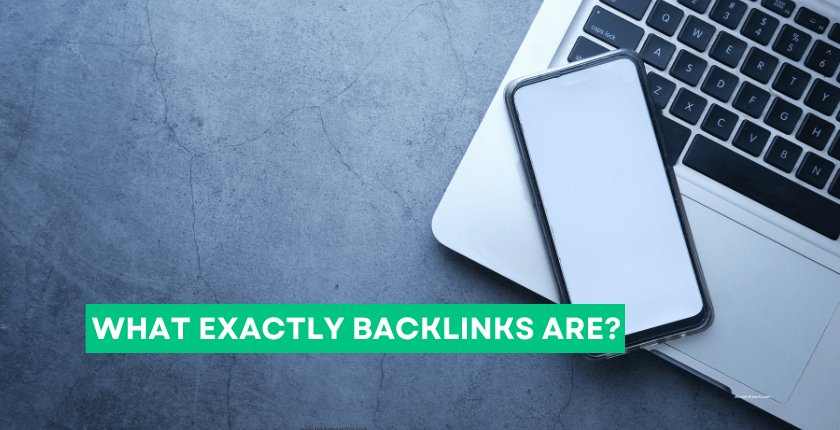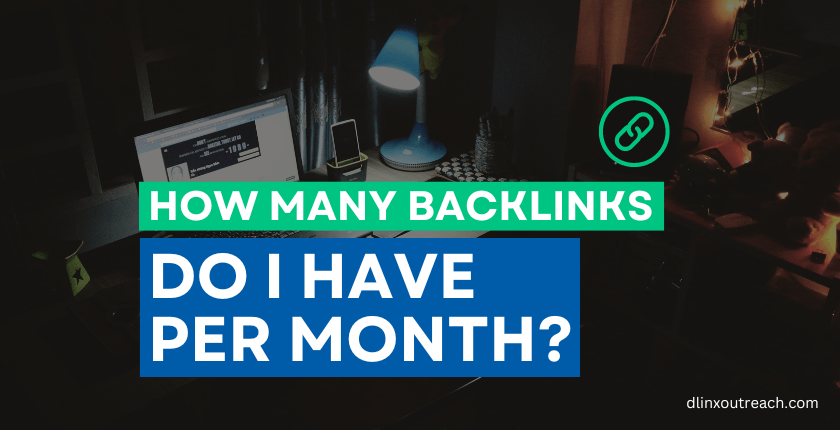Backlinks are still a hot topic to discuss in digital marketing in 2023; the question of how many backlinks you should aim for each month is a common one. Let’s discuss this topic and provide you with insights and recommendations to navigate the world of backlink acquisition effectively.
Let’s start.
How Many Backlinks Do You Need Each Month?
The number of backlinks you should aim for each month depends on several factors, including the age of your website, your industry’s competitiveness, and your current backlink profile.
Let’s break it down:
#1. New Websites: If you’ve recently launched your website, it’s crucial to start with a conservative approach. Aim for 5-10 high-quality backlinks per month. This gradual growth will help you establish a solid foundation without triggering any search engine alarms.
#2. Established Websites: For websites that have been around for a while and already have a strong backlink profile, you can be a bit more ambitious. Aim for 10-20 high-quality backlinks per month to maintain your rankings and potentially climb higher.
#3. Industry Competition: Consider the competitiveness of your industry. Some niches are highly competitive, requiring more aggressive backlink strategies. Keep an eye on your competitors and adjust your monthly goals accordingly.
#4. Content Quality: High-quality, valuable content tends to attract backlinks naturally. Focus on creating exceptional content that people in your industry want to link to. Quality content can lead to an increase in backlinks without a specific monthly target.
Quality Over Quantity
In the world of SEO, quality always trumps quantity. Google’s algorithms are adept at distinguishing between valuable, relevant backlinks and spammy, low-quality ones
#1. Natural Growth: Sudden spikes in backlinks can raise red flags. Strive for a natural, gradual growth pattern that aligns with your website’s growth.
#2. Relevance: Backlinks from websites related to your niche or industry carry more weight. Focus on obtaining relevant backlinks to boost your authority.
#3. Authority: Prioritize backlinks from authoritative and reputable websites. One high-quality backlink can have a more significant impact than several low-quality ones.
#4. Diversification: Diversify your backlink sources. This can include guest posts, social media mentions, collaborations with influencers, and more.
What Are Exactly Backlinks? and Why Do They Matter?

Backlinks are like digital votes of confidence for your website. They are links from other websites that point to your site. These backlinks tell search engines that your content is valuable and trustworthy.
Here’s why they matter:
#1. Improved SEO Results: Backlinks play a crucial role in enhancing your website’s off-page SEO. Search engines like Google consider the quality and quantity of inbound links when ranking your site.
#2. Higher Ranking: Backlinks can boost your website’s ranking on search engines like Google, Bing, and Yahoo. Higher rankings mean more visibility to potential visitors.
#3. Increased Sales: When your website ranks higher and attracts more visitors, it can lead to increased sales and revenue for your business.
#4. Google Discovers Your Content: Backlinks make it easier for search engines like Google to discover and index your content. They follow these links to find new pages on your site.
#5. Enhanced Credibility: Backlinks act as third-party endorsements, increasing your website’s credibility in the eyes of both users and search engine algorithms.
Read | How Many Backlinks Per Day Is Safe?
Top Reasons Why Backlinks Are Important
You might be wondering why backlinks hold such significance, especially now that we have a clear understanding of what they are. Backlinks are the unsung heroes of the digital landscape, playing a pivotal role in the success of websites. Let’s embark on a journey to uncover the multifaceted importance of backlinks.
#1 Reason: Enhancing Your SEO Landscape
First and foremost, backlinks are a cornerstone of effective Search Engine Optimization (SEO). In the vast online realm, where competition is fierce, standing out is imperative. Unfortunately, many small businesses dabble in SEO, often limiting their efforts to on-page optimizations like incorporating target keywords into website content. While on-page SEO is vital, it’s the off-page aspect, propelled by backlinks, that can truly elevate your SEO game.
#2 Reason: The Power of Quality Backlinks
Imagine Google’s algorithms as intricate judges assessing your website’s worthiness. They meticulously evaluate your backlink profile, scrutinizing the quality and quantity of inbound links. The verdict is clear: the more high-quality backlinks you secure, the higher your overall SEO ranking.
#3 Reason: Elevating Your Digital Presence
Now, let’s talk about the holy grail of online presence – ranking high on search engines like Bing, Google, and Yahoo. Achieving a prominent position on the Search Engine Results Pages (SERPs) is a coveted goal for many website owners. It’s not just about bragging rights; it’s about visibility.
At the core of Google’s ranking algorithm lies the PageRank process. This algorithm heavily factors in inbound links when determining a web page’s significance. In essence, the more links point to your page, the more valuable it becomes in the eyes of search engines. This translates to a higher position in SERPs for relevant searches or keywords.
#4 Reason: Sales Booster
Now, let’s connect the dots between backlinks and your bottom line. Picture this: your website ranks among the top results on SERPs, and a steady stream of visitors click on links from various sources to access your content. What’s the result? An influx of visitors to your site, and with that, a higher likelihood of conversions.
In simple terms, backlinks can be a driving force behind increased revenue for your business. As part of a well-executed SEO campaign, they can contribute significantly to your company’s top-line income.
#5 Reason: Guiding Google to Your Content
Think of backlinks as a GPS system guiding Google to discover your digital content. When Google follows a backlink to a new page, it embarks on a journey, crawling that page to unveil all its hidden treasures. Here’s where your internal linking strategy comes into play.
Internal links, those that connect pages within your website, help Google navigate your website’s intricate structure. Google meticulously analyzes your site, indexing each page it encounters. Consequently, your pages stand a greater chance of appearing in search results, further enhancing your online visibility.
#6 Reason: Elevating Your Brand’s Credibility
Let’s touch on the credibility factor. Backlinks serve as endorsements for your website. They act as third-party validations, both for human visitors and the ever-discerning search engine algorithms.
Google’s mission is clear: to provide users with the most relevant and valuable results. To achieve this, it rigorously evaluates every web page in its vast index, determining which URLs are the cream of the crop. When Google bestows high rankings upon your content, it instills trust in the hearts of searchers.
Read | What Is Testimonial Link Building And Its Importance?
What Are The Most Important Elements Of Good Backlinks?
Not all backlinks are created equal. Various factors influence the quality and value of a backlink. Let’s delve into the essential elements that set good backlinks apart.
The Natural Approach
One fundamental principle guides the world of backlinks: authenticity. Gone are the days of spammy links, site-wide footer links, or bizarre anchor text randomly embedded in phrases. Link farms? Those belong to the past as well. The key today is to acquire backlinks in the most natural way possible.
This natural approach is your shield against the dreaded Google penalty, a penalty that can have dire consequences for your website’s ranking.
The Anchor Text Puzzle
Now, let’s focus on the anchor text and the actual content of the backlink. For instance, in a link like “Google’s Search Quality Guidelines,” the anchor text is “Google’s Search Quality Recommendations.” Anchor text can vary in style and size, but it holds a crucial role in backlink dynamics.
In the early days, Google’s PageRank algorithm relied heavily on anchor text as a key ranking factor. However, as with many aspects of SEO, experts sought to manipulate the system by creating hundreds of exact-match backlinks. Unfortunately, this often had a negative impact on the user experience.
To combat this issue, Google introduced the Penguin Update. This update aimed to counteract spammy anchor text practices.
Precise anchor text helps both people and search engines understand the content of the linked sites. When proper anchor text is used, visitors and search engines can quickly discern the content’s essence.
Authority Links: Bridges for All
Consider authority links, whether they are external or internal, as bridges connecting people and search engines to valuable content. These links serve as pathways to essential information and contribute to the overall user experience.
Now that we’ve explored what makes a backlink valuable let’s venture into the territory of what makes them detrimental.
Unmasking the Culprits Behind Bad Backlinks
Bad backlinks are the antithesis of their valuable counterparts. Let’s shine a light on the four types of troublesome linkages that you should be cautious of:
Inappropriate Links
A link from a high-domain-authority website that bears no relevance to your company or area of expertise is essentially pointless. It won’t bring relevant referral traffic to your website, and Google’s algorithms won’t view it favorably. In essence, it’s a futile attempt to boost rankings.
Purchased Links
Purchasing backlinks may seem tempting, with link farms and offers of high DA40+ backlinks for a fee. However, Google has cracked down hard on sponsored links. Google not only receives spammy links from individuals but also has a dedicated human spam team that actively seeks out purchased links. Additionally, its algorithms have become adept at detecting unnatural linking practices.
Resist the allure of buying links. It’s a risky game with potential repercussions.
Site-Wide Links
Site-wide backlinks, those displayed at the bottom, header, or sidebar of another website and visible on every single page, were once a popular tactic to manipulate rankings. Placing a link in the footer, for instance, could result in thousands of links, seemingly boosting a website’s authority.
However, this strategy has lost its sheen. Nowadays, Google takes a dim view of having thousands of backlinks pointing to the same page from a single domain. If you don’t want to risk a Penguin penalty, it’s essential to understand that Google doesn’t treat all backlinks equally.
While there are valid reasons for having site-wide backlinks, such as showcasing credits for web development or design, trying to deceive Google with this strategy is unlikely to succeed.
Press Release Links
SEO specialists have been known to inundate press releases with numerous links before syndicating them to various press release distributors. However, Google updated its webmaster guidelines in 2013, stating that press release links should be followed. Google began treating press releases similarly to advertisements.
Read | What Is The Difference Between Backlinks And Link Building?
The Definitive Guide To Getting Quality Backlinks Month Wise
After a lot of discussion about the value of offsite link building, it’s time to learn how to obtain it. One thing is clear, as has been stated several times: there is no alternative to high-quality material.
Whatever SEO best practices one applies, nothing will be effective if the quality of the material is enough. Furthermore, this fact is equally important for every discipline. The material must be sufficiently strategic and focused on the desired keywords.
Discussion Boards
There are forums for almost every topic on the internet. Then there are sites like Wikipedia or Quora, which respond to people’s inquiries and concerns. Article submission on these networks is one of the most dependable methods of obtaining backlinks. This is an effective approach, and the good news is that it works.
This indicates that these approaches are still applicable in present times. But again, the information must be of good quality.
However, links shouldn’t be included in every other topic or discussion. To obtain backlinks, it is best to stick to those that are relevant to the niche or, more specifically, the content of the relevant post. Adding links to any random topic is considered spam.
As previously stated, Google penalizes such sites in the majority of scenarios. In a nutshell, such practices should be avoided. The same thing may be applied to the discussion forums.
These sites offer a fantastic opportunity to obtain backlinks from authoritative websites. You can create these types of backlinks monthly, and it’s safe to create them.
Channels For Submitting Content
One of the most effective tactics in this respect is to use content submission sites. When accepting material from these sites, they frequently issue do-follow links or suggest links to the relevant site.
Nevertheless, checking that the content submission platform is reputable is critical. There are several directory sites for articles that may be used to obtain backlinks. To be strategic in this subject, make sure the directory in question is niche-specific.
Read | How Much Does Link Building Cost?
Take Advantage Of Influencers
It may not be considered a standard SEO best practice, but it is one of the oldest and most effective methods for staying in touch with industry leaders. In this aspect, LinkedIn may be an excellent resource. It is also a fantastic approach to use techniques such as giveaways, contests, and so on; they provide a tremendous opportunity for advertising the concerned site.
At the same time, one must participate in competitions, giveaways, and other activities of other sites associated with the concerned niche. It’s an established way of obtaining natural links and a more thoughtful way of advertising the site. It also significantly boosts the brand value of the concerned site.
Guest Posts
Guest posts are widely regarded as a trustworthy SEO best practice for obtaining backlinks. The most important thing is that Google approves of this backlinking method. Furthermore, the emphasis is on creating guest posts on the top-ranked sites in the relevant category.
However, one is not supposed to anticipate immediate results from this technique for obtaining backlinks. Most essential, the content must be of sufficient quality. In reality, authoritative sites simply do not accept guest posts unless the content is of satisfactory quality.
Those who are beginners to blogging should take their time with this. However, if the quality is good, the outcome is almost guaranteed.
Social Networking Sites
Aside from this, social media sites might be of use. Sharing posts or links to posts on the official social media page has been demonstrated to boost reach significantly. Links may additionally be left in the comment areas of social media posts. However, it should not appear to be a spam technique. It should be pertinent to the current conversation.
Discussion Boards
There are forums for almost every topic on the internet. Then there are sites like Wikipedia or Quora, which respond to people’s inquiries and concerns. Article submission on these networks is one of the most dependable methods of obtaining backlinks. This is an effective approach, and the good news is that it works.
This indicates that these approaches are still applicable in present times. But again the information must be of good quality.
Read | What are the Benefits of Guest Posting?
Get The Anchor Text Game
Anchor text is quite important in terms of SERP ranking. This is the real text that the relevant page employs to link to the material of the site that receives a link. Thus, choosing the correct anchor text that is frequently utilized by people on search engines or by other bloggers should be employed.
Furthermore, the material must be optimized for the anchor text. Above all, the anchor text should not be jammed or interfere with the flow of the material in any way. It is also critical to make sure that the most appropriate website is linked for the appropriate anchor text.
Make assured that the link on the page is of high quality. While optimizing your site, it is essential to ensure that the site linking to yours is as reputable. As previously said, gaining backlinks from authority sites typically proves a great deal more helpful in terms of ranking.
How Many Backlinks Do I Have Per Month for a Website?
We all understand the pivotal role that inbound links play in a website’s growth and overall performance. Assuming you’re here, it’s safe to say you’re well aware of this fact.
Additionally, it’s worth noting that Google requires some time to index the pages of your site. Therefore, maintaining a consistent and systematic approach to backlink building is a prudent strategy. The concept of a backlink growth rate has been a topic of discussion in the SEO industry for quite some time, and it continues to hold relevance today.
For those who are new to this field and are in the process of establishing a new website, here’s a straightforward approach you can consider.
Month One: The Gradual Start
In the initial month, it’s advisable to take it slow and steady, like laying a foundation. Begin by creating what are commonly referred to as “pillow links.” These are essentially low-impact links that help establish your online presence. These can include activities like networking on social sites, building your profile, engaging in forums, and more.
When incorporating backlinks to your internal pages during this phase, focus on using natural and contextually appropriate anchor text. It’s also acceptable to explore opportunities like guest blogging or niche edits to bolster your link profile.
While we can’t provide you with specific numerical targets, we recommend conducting a competitive site analysis. By studying the growth patterns of well-established websites in your niche, you can gain valuable insights. You’ll likely observe a trend of gradual and progressive expansion over time.
Remember, the key is to strike a balance between consistency and quality when it comes to backlink building. By adhering to these principles and staying attuned to your specific audience’s needs and interests, you’ll be on the right path to a successful link-building strategy.
Natural-looking growth might resemble this:
- Initial month: Ten backlinks to the main page (given that this is a fresh site with little content).
- Second month: twelve links to the main page.
- Third month: 17 backlinks, primarily to your homepage.
- Fourth month: 19 backlinks, with 3/4 of them pointing to your homepage.
- Fifth month: 25 backlinks, half of which go to internal sites.
- Sixth month: 30 backlinks, half of which lead to internal sites.
Let’s get one thing straight: link building isn’t about reinventing the wheel or following rigid, mechanical formulas. It’s a nuanced process that combines strategy, creativity, and adaptability.
When contemplating your monthly backlink growth rates, especially for a relatively new website, it’s important to understand that these rates may initially appear on the higher side. Why? Because, in the early stages, there’s a need to actively seek out and establish a network of links to gain traction. However, as your website matures, the pace of acquiring backlinks is likely to slow down naturally.
So, what’s the safe and methodical way to expand your link profile? It involves gradually increasing the number of quality links you acquire each month. But remember, this increase shouldn’t be overly aggressive in relation to your overall backlink portfolio.
In essence, start off at a measured pace and then gradually ramp up your efforts. The key here is maintaining a diverse set of links at all times. Quality should always be prioritized over quantity.
Now, if you’re inclined to take a more quantitative approach to your strategy, you can consider conducting ad hoc tests or performing competitive analyses. These techniques can provide valuable insights and help refine your approach.
Read | How to Get a Permanent Backlink?
Final Thoughts
In the world of SEO, there’s no one-size-fits-all answer to the question of how many backlinks you should aim for each month.
Quality should always be your priority, and the quantity should align with your website’s specific circumstances.
Regularly assess your backlink profile, monitor your rankings, and adjust your strategy as needed to achieve sustainable SEO success in 2023. Remember, it’s a marathon, not a sprint.
Dlinx Outreach offers you the best service in the SEO market, and they help you create the most appropriate backlinks relevant to your business. Contact us if you want to see real outcomes from your link-building efforts.
Related Articles:
- Link Building Metrics
- How to Get Natural Backlinks
- How to Write an Engaging Blog Post
- What Is Manual Link Building?
- What is Editorial Backlink
- Do Backlinks Build Authority of a Website
- How Many Backlinks per Month Are Safe
- What is Link Farm in SEO
- Buying Backlinks like a Pro
- Are Nofollow Backlinks Useless
- Is Google 100 Percent Accurate
- Why Is Content-Based Link-Building Effective
- What is the Difference Between Google Sites and Blogger







